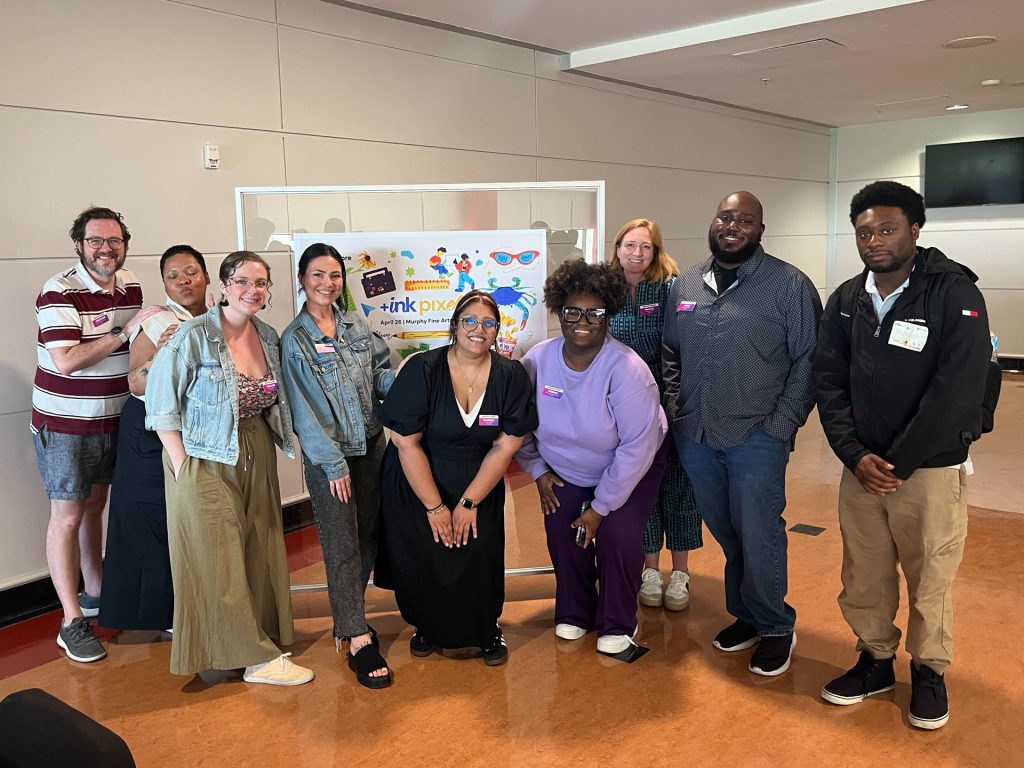On Thursday, October 27th, 2022, AIGA Baltimore held an in-person panel discussion for “Figma: Fad or Future,” which culminated AIGA’s Baltimore Design Month 2022. The discussion featured Mindgrub’s creative team sharing their transition to Figma, cross-departmental collaboration, thoughts on Adobe’s acquisition of Figma, and their predictions for the future of design software.
The panel included Mingrub’s Emilee Beeson, Art Director; Evan Reisberg, Interactive Design Manager; Steph Loughran, Product Design Manager; Sandra Koranteng, UX Designer; Alex DeRito, Developer; and was moderated by: Benjamin Guarino, UX|HCD Specialist.
Watch the full video, and read on for a recap of key takeaways.
Q: How do you see Figma being transformed by this acquisition?
Some of our panelists noted that although the acquisition is shocking, it would likely make Figma a stronger platform and more future-proof. With Figma being so near and dear to people heart’s, the hope is that the interface will not change drastically; rather, it will be improved upon. They are looking forward to seeing how Adobe integrates with Figma, with Adobe’s being able to support Figma with options such as vector capabilities and a more extensive font library.
Q: How has Figma impacted the way your team collaborates?
Adopting Figma has made it easier for the Mindgrub team to collaborate on complex prototypes in one location. It challenged them to become transparent and organized with their process, structure, and handoff. Additionally, using Figma has encouraged more ideas and resource sharing among team members. They can see how others set up their file, which has helped build their process. Figma has been a huge step forward compared to Sketch and has reduced the number of different software designers used for a project.
Q: How has Figma supported Mindgrub’s work from anywhere/anytime policy?
With Mindgrub’s improved workflow on Figma, they can collaborate efficiently across time zones, reducing back and forth and making it easier for people to jump back into their projects anytime. Having a stable structure also helps Mindgrub build trust with clients because it allows clients to see the progress being made and what the team is working on. Figma is also great for making real-time updates to projects sent to clients.
Q: Do you think Figma will stand the test of time in 10 years or more?
Some of our panelists believe that Figma can get the rug pulled from under them if they don’t keep up with a design to code. Competitor programs like Web Flow, with easy-to-use and evolving technology, can creep up on Figma if they don’t keep up. However, the Figma community is fantastic and has tons of plug-ins, resources, and events that will support Figma’s growth over the years to come. Other thoughts shared are that although design to code is interesting, there needs to be a happy balance with evolving technology where we can automate some of our work without losing the human touch to create something unique and personal.
Q: What are some limits of Figma that you want improvement on?
Evan would like to have scroll trigged animation in prototyping. That’s an element he goes out to another application to create. Emilee shared that creating custom artwork in Figma is challenging. She often has to switch to Photoshop but hopes that Adobe will add the library-sharing feature between Photoshop and Figma so she can work between both applications without having to export.
Audience Q&A
Q: While designing in Figma, are you developing content as well? Which stage do you involve a content strategist in?
Some of our panelists noted that they don’t use the real copy in the flat design. The content strategist or copywriter often collaborates with the client on a platform they are more comfortable with, and they later integrate the content into the design. But it ultimately depends on where the content strategists are comfortable working, whether in Figma simultaneously or separately in a Word document. However, the client might be more focused on the content than the design if actual content is used.
Q: How do you display your designs to clients for mobile and desktop views?
Depending on the project and team, they present a few different size artboards to give clients an understanding of the project view ranging from mobile to small laptop to huge monitor sizes.
Our panelists shared their top advice for teams transitioning to Figma:
Establish a culture of sharing – Emilee shared that it can be easy for creatives to be guarded in a competitive environment, so establishing a culture of sharing is really important. Emilee feels comfortable with her team because they are all working together to learn the program and know it’s okay to make mistakes when learning.
Learn the basics – Steph recommends learning auto layout first because it saves time when adding new content. Steph believes this tip will change your life.
Talk to your local Figma Evangelist – Sandra recommends reaching out to those on your team who are really experienced with Figma for tips. Getting support from Figma evangelists like Evan and Emilee has been helpful. She also recommends learning how to use components.
Embrace the change – As a developer, Alex feels the benefit from collaborating in Figma and shares that fellow Developers shouldn’t be a blocker to transitioning.
Be open to showing your style – Get comfortable with having everyone on your team being able to access the project and see how you work. Evan shares that being able to see each other’s work has allowed the team to learn each other’s design preferences.
Some of our Panelist’s Favorite Figma Plug-ins
- Spellcheck: Check your spelling as you work on Figma.
- Unsplash: Insert beautiful images from Unsplash straight into your designs.
- Color Contrast: Check contrast according to WCAG guidelines and apply changes directly to your artwork.
- Stark: A combination of integrated tools that help you streamline your accessibility workflow.
- Google Sheets Sync: Sync data in a spreadsheet to elements in your design.
- Content Reel: Quickly insert text-based content into your design, such as names, phone numbers, US addresses, emails, URLs, and more.

